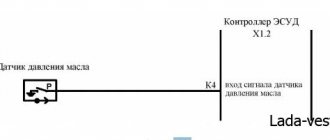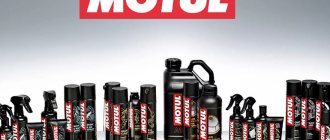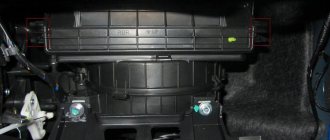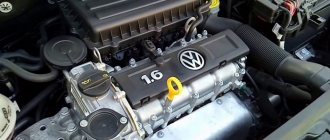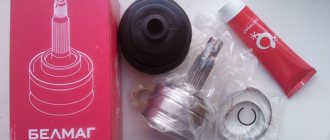Most modern motor oils are universal and all-season. They can be poured into both gasoline and diesel engines in winter and summer. The SAE temperature range is indicated by numbers separated by the letter W, indicating winter.
For example, 15W40. Here the letter refers to the first digit. In this case, the first numbers indicate low temperatures at which the oil will not become very thick. The last figure is related to the summer operation of the car. It shows at what high temperatures the lubricant will not be too liquid. If you ignore these parameters, the engine oil will not be able to perform its functions.
Look at the instructions
This is universal advice for many operations that you carry out on your car. If the car is under warranty, then you cannot violate the instructions, and it is better to have the work performed by an authorized dealer.
Let me remind you that the viscosity of the oil, which directly affects the temperature range of operation, is denoted by two numbers and the letter W according to SAE. An example is the designation 5W-40. The first number characterizes the low-temperature properties of the oil, and the second determines its behavior at engine operating temperatures.
Rating of all-season oils ideal for summer
Based on their composition, mineral, synthetic and semi-synthetic motor oils can be distinguished:
- Minerals are a product of direct oil refining. This natural lubricant has certain disadvantages. On the other hand, it is the safest for old worn-out engines. The most commonly used viscosity here is 15 W-40, 20W-50.
- Semi-synthetics combines a mineral and synthetic base. Suitable for extreme temperatures and high speed.
- Synthetic oils were created in laboratory conditions, so they can boast better performance in protecting the engine. But such compositions contain additives that are aggressive towards rubber seals and gaskets. Therefore, synthetics with a viscosity of 5W-40 are better used for modern power units. The following brands of oil are best suited for summer use.
What region do you live in?
If your place of residence is the southern regions of the country, then it is better to use summer oil - for example 15W-40 or 10W-50. But with the same success, you can use an all-season oil with a “big” second number - 40 or 50. But if you live somewhere beyond the Urals, in areas with a sharply continental climate, then it is advisable to think about dividing the oils into winter and summer.
Filling with high-viscosity oil is a good idea for residents of areas with hot summers.
Filling with high-viscosity oil is a good idea for residents of areas with hot summers.
All-season characteristics
The name itself suggests that this substance can be used in all seasons of the calendar year. All-season lubricants are designated SAE 0W-30 or 0W-40 to SAE 20W-40 and are a symbiosis of summer and winter lubricants. Moreover, the first letter indicates the level of viscosity at negative temperatures, and the second letter characterizes the above-mentioned indicator at positive ambient temperatures.
Good to know: Which motor oil is not counterfeited in Russia, list of the best
Actual motor condition
When deciding whether to use summer oil, you need to evaluate the actual condition of the engine. If the engine reaches its last thousand kilometers before being written off or overhauled, then it is advisable to pour the thickest summer oil into it so that the end of operation does not come suddenly, but as planned.
The brand can be anything. Viscosity and quality are important.
The brand can be anything. Viscosity and quality are important.
Classification of motor oils
To make the right choice and finally decide which oil is best to pour into the engine in summer and winter, you need to understand the types and properties of lubricants on the market today.
The composition of motor oil implies the presence of a base base, as well as special additives that affect the characteristics and properties of the substance. The base is various oil fractions that are formed during the processing of oil and/or the synthesis of organic compounds. Based on these fractions, motor lubricants are divided into:
- mineral;
- semi-synthetic;
- synthetic.
Both types of “synthetics” demonstrate characteristics and properties superior to those of their mineral counterparts, which is reflected in a higher price.
Viscosity and temperature resistance determine whether motor oil belongs to three groups:
- Summer.
- Winter.
- All-season.
The latter option is the most in demand and popular, since it allows you to avoid the procedure of changing the lubricant in the off-season.
What about brands?
I am sure that in the motor oil market there are no outright leaders and absolutely lagging behind. The main thing is that you do not purchase a fake. Therefore, I advise you to buy oil at branded gas stations and large chain auto parts stores. Make sure that the API quality level is no worse than that prescribed by the manufacturer. Let me remind you that the line of oils, as quality increases, looks like this for gasoline engines: SL, SM, SN, SN plus.
Oil change intervals in summer
When producing ROLF motor oils, their characteristics not only meet the requirements of the declared quality classes and manufacturer approvals, but also exceed them with a margin sufficient for long-term operation of the product. However, increasing the replacement period established by the car manufacturer is not recommended.
The fact is that replacement intervals are set by factories so that after their expiration the oil does not “go to zero”, but retains a sufficient level of protective properties, and the viscosity does not exceed the requirements of the standard. The quality of engine oil is one of the main factors affecting engine life. It is impossible to independently determine the timing when the oil will “use up”, if they are not indicated in the service book, without laboratory tests. Therefore, when choosing ROLF products, follow the intervals recommended by the manufacturer.
Should I mix oils of different viscosities or not?
Surely many inexperienced motorists are wondering whether it is possible to mix semi-synthetic oil with pure synthetics. This question arises especially when it is sharply cold outside, but fresh semi-synthetic oil has already been poured into the engine.
In this case, if you want to save money, the car enthusiast will probably just want to add synthetics that are more resistant to low temperatures. Of course, even adding a small amount of pure synthetics will significantly improve the quality of the original (semi-synthetic) oil filled in early. On the other hand, a compatibility problem arises here, because not every synthetic can be mixed with semi-synthetics. Based on this, we can conclude that before the winter season the best solution would be a complete switch to synthetic oil. To do this, you need to drain the semi-synthetic and flush the engine, replace the oil filter and fill with fresh synthetic oil.
The best winter oils
1.Lukoil Lux SL/SF 10W-40 is a Russian-made semi-synthetic oil, made on an all-season basis and suitable for gasoline and diesel power plants. Recommended not only for VAZ and foreign cars, but also suitable for minibuses and LCV cars. This semi-synthetic increases the service life of the internal combustion engine and ensures quick start-up at low temperatures. In addition, this oil does not have a negative effect on the catalytic converter. 2.TNK Magnum Motor Plus 10W-30 is an all-season “mineral water” at an affordable price and with improved characteristics. This modern product is suitable for VAZs and foreign cars with gasoline and diesel engines. TNK oil ensures reliable starting at temperatures down to minus 25 degrees. Moreover, the effectiveness of the oil does not depend on the class of the car - be it cars, trucks, minibuses, etc. Based on reviews, you can be convinced that this oil works well both in winter and in summer until the next scheduled replacement. 3.Shell Helix Ultra ECT C2/C3 0W-30 is one of the best winter oils for diesel cars. Made on a synthetic base with the addition of potent components that improve engine performance and reduce CO2 emissions. With this oil, you can be sure of trouble-free starting of the internal combustion engine in harsh winter conditions. 4.Castrol Turbo Diesel 0W-30 is an expensive synthetic oil for modern turbocharged diesel engines. Contains a wide range of powerful German-made beneficial additives that reduce CO2 levels and increase engine endurance under extreme loads. This liquid has approvals from premium brands such as Mercedes and BMW. In addition, Castrol oil never darkens and is adapted to the harsh Siberian frosts. 5.Ravenol Arctic Low Saps ALS 0W-30 is a specialized oil for winter operation at temperatures down to minus 52 degrees, which makes this lubricant suitable for the most severe climatic conditions. This is due to the high viscosity and high-strength oil film, as well as good pumpability and instant start of the internal combustion engine in the most severe frosts at minus 35 degrees. and below. In addition, Ravenol oil practically does not age and helps reduce fuel consumption. 6.Liqui Moly Synthoil Longtime Plus 0W-30 is one of the best winter oils for operation at temperatures approaching minus 40 degrees. Has all the benefits of premium oils
Automaker recommendations
In addition to a whole bunch of different international classifications, motor oils are also approved by specific car manufacturers. This is usually an alphanumeric code that can be found directly in the name of the branded oil. For example: Renault names its standards with the letters RN and a digital code like 710, Mercedes-Benz uses indexing similar to MB 229.51.
Sometimes compliance information can be found on the back of the canister in the form of a line with the inscription Approved for and a list of brands.
In fact, product compliance with design requirements is the easiest way to select engine oil. Finding out what composition the manufacturer recommends is as easy as shelling pears. The data is contained in the vehicle owner's manual. If you don’t have it at hand, then you can look for the answer on the Internet, including on the websites of oil manufacturers. Quite a few of them now offer online engine oil selection services.
On the market you can also find oils that are sold under the brand of specific car brands. Note that this does not mean that UAZ, for example, produces motor oil independently. It is made by Lukoil
Important: when considering an oil approved by a car manufacturer, it is important not to forget about the operating conditions and select the SAE viscosity value based on them.
Oil volume in the VAZ 2115 engine
| Engine | hp | Year of release (beginning-end) | Engine oil volume, l | |||
| 1.5 | VAZ-21083 | B | 70 | 1997 | 2000 | 3.50 |
| 1.5 | VAZ-2111 | B | 78 | 2000 | 2008 | 3.50 |
| 1.6i | VAZ-11183 | B | 80 | 2008 | –> | 3.50 |
What is viscosity index and oil dilution degree?
The performance characteristics of a particular oil from different brands are compared based on key parameters, one of which is viscosity. The strength of the lubricating film that forms on the piston group and other parts of the engine depends on the viscosity index. Thicker oil with a thick and durable film increases the load on the internal combustion engine and reduces its efficiency, while a thinner film is not able to provide maximum protection for the internal combustion engine from wear and dry friction for a long time.
Therefore, for stable engine operation in the winter, a compromise solution is needed, which is oil with moderate viscosity - that is, not too thick so that the oil retains its fluidity after the engine warms up. When used in summer, the requirements are not so serious, so you can even fill in thick oil, because it still won’t freeze at above-zero temperatures.
On the packaging of the canister, the manufacturer indicates the viscosity index, which determines the thickness of the oil. With a lower index, the oil loses its thickness, and the protective film of such a liquid is thinner. Because of this, it is recommended to shorten the oil change period, otherwise premature wear of internal combustion engine parts is possible due to a thinner oil film. Oil with a high index is distinguished by its thickness and less fluidity. This allows you to envelop the internal combustion engine parts with a durable and thick oil film, which retains its structure for a long time and increases the oil change interval.
Using the viscosity index, you can determine the degree of dilution of the oil. After starting, the engine begins to warm up, and as it warms up, the oil gradually dilutes, which at the same time becomes less frequent due to the increase in temperature. In essence, the degree of dilution is the viscosity index, presented on paper as a simple numerical value without units of measurement. Below are common indices depending on the type of oil.
- Mineral oil – 110-135
- Semi-synthetics – 130-150
- Synthetics – 140-170
This is why synthetic oil is best suited for winter use, because it has the highest viscosity index. Mineral oil, due to its lower index, on the contrary, ages faster and loses its performance characteristics, which is why it is necessary to reduce the replacement schedule. In the summer, any viscosity index is suitable, but before the onset of winter it is better to switch to synthetics or, in extreme cases, semi-synthetics.
SAE classification
To determine the appropriate winter or summer oil, you need to familiarize yourself with the so-called SAE classification, which varies depending on the viscosity of the lubricant. So, SAE has different markings - 0W, 10W, 20W, 25W, etc. For example, in an oil marked 5W-30, the number “5” indicates the maximum sub-zero temperature for which the oil is designed. Next comes the letter “W”, which makes it possible to use this oil in the winter season. The number “30” is the maximum temperature unit for positive temperature at which the lubricant retains its performance characteristics.
So, let's look at the most common SAE classifications to understand their purpose depending on weather conditions, engine type and vehicle condition:
- 5W-30/5W-40 is the most versatile and widespread oil with good temperature resistance. It is used for diesel and gasoline cars
- 0W-20/0W-30 - this SAE viscosity is recommended for use in the northern and central regions of the Russian Federation with harsh climatic conditions
- 0W-40/0W-50 - specific all-season oil, not suitable for all types of internal combustion engines
- 10W-30 is another universal oil that is suitable for operation at positive and low temperatures below 25 degrees
- 10W-40 is the optimal SAE option for the southern regions of the Russian Federation with a mild climate
- 15W-40 – recommended for diesel and gasoline cars with high mileage
How to determine the seasonality of oil according to SAE
To consolidate the above material, the SAE classification can be divided into three groups of oils:
Winter - marked 0W, 5W, 10W, 15W, 20W, 25W. The number in this case indicates the maximum permissible sub-zero temperature, and the letter W means winter oil
Summer - marked 20, 30, 40, 50 and 60, where the number indicates the maximum permissible positive temperature above 0 degrees Celsius
All-season oil is the most popular oil. It is universal due to the fact that it does not have to be changed before the winter season or with the arrival of spring. In other words, you can drive with this oil all year round. The marking of all-season oil is as follows:
- 0W-30 – suitable for temperatures from -30 to +20 degrees.
- 0W-40 – for temperatures from -30 to +35 degrees.
- 5W-30 – from -25 to +20 g.
- 5w-40 – from -25 to +35 gr.
- 10W-30 – from -20 to +30 gr.
- 10W-40 – from -20 to +35 gr.
- 15W-40 – from -15 to +45 gr.
- 20W-40 – from -10 to +45 gr.
API classification
Let's briefly consider the API classification so as not to encounter incomprehensible designations when choosing a suitable winter/summer oil depending on the type of internal combustion engine and the year of manufacture of the car - in fact, these are the main indicators from which to proceed when selecting the optimal API classification, which is indicated in in the form of various symbols:
C - for diesel engines S - for gasoline engines S/C - can be used for diesel engines, but is better suited for gasoline internal combustion engines C/S - on the contrary, better for diesel engines, but in extreme cases it is also suitable for gasoline engines
After one of these letters there is a second letter, which, in ascending alphabetical order, determines the compatibility of the oil with more modern or older cars.
For example, API-SL and API-SN for old and new gasoline cars, respectively. The same situation is with diesel engines - API-CI and API-SJ for old and new car models, respectively.
ACEA classification
Let's briefly consider the ACEA classification so that when studying the characteristics of a suitable winter/summer oil, there are no unclear designations. The ACEA classification is first designated by a letter indicating the engine type. Next comes the number - the higher it is, the higher quality the oil is and is suitable for modern engines (or vice versa).
A – for petrol B – for diesel engines E – for diesel trucks C – universal oil for petrol and diesel engines
Owner experience, including that confirmed by laboratory tests
Owners of cars produced by the Volzhsky Automobile Plant, using 5W-30 lubricant for engines, talk about the results.
Lev from Tyumen uses Lukoil synthetic oil 5W-30 for his Lada Vesta and believes: “Viscosity does not depend on the external air temperature, but on the local temperature. A difference in external temperature of 5-10°C cannot be the main factor when choosing a motor lubricant. If the engine does not operate for a long time at maximum power and high speeds, and the cooling system is working properly, then you can use 5W-30 without undesirable consequences even at +30°C and above.”
Alexander, Novosibirsk: “I have been using Lukoil synthetic 5W-30 for 3 years in Lada Granta. Everything is clean under the valve covers! Starts great in winter."
Konstantin, Arkhangelsk: “The total mileage of the Lada Kalina is 102 thousand km. The mileage on Lukoil synthetic 5W-30 is 13 thousand km. I change the lubricant every 9 thousand km. The unit is clean and works like a clock. I like".
Dmitry, Volgograd performed an analysis at PLM laboratories of used 5W-30 oil on a Lada Granta after 5960 km of mileage over 1.5 months at summer temperatures from +15°C to +40°C. The overall assessment of the analysis is “norm”. He believes: “The result is excellent. Everything is ideal."
Car with high mileage
After purchasing a car second hand, the first thing you need to do is determine whether there are problems with the engine. Based on the information received, you can find out which oil is best to pour into the engine.
Diagnostics of the internal combustion engine will help identify problems in the functioning of the oil system, the causes of extraneous sounds and the need for repairs. If everything is in order with the motor, then all that remains is to choose the right lubricant. To do this, you should listen to the following recommendations.
- The type and type of oil must comply with the automaker's regulations for a specific vehicle model.
- You should not choose lubricants with minimum acceptable parameters. In such a situation, it is recommended to select formulations from the top or middle range according to API and/or SAE.
- It is prohibited to use oils with reduced tolerances and parameters. It should also be taken into account that the market offers specialized compounds for old cars.
Experts also recommend using new lubricants of the latest developments for filling the internal combustion engines of cars with high mileage. However, as with every rule, there may be exceptions. Thus, there are some restrictions on the use of modern motor oils. First of all, they use lubricants with a low temperature shear viscosity. These compositions are “tailored” for new engines characterized by economical fuel consumption, and therefore cannot be used in ancient power plants.
In veteran cars, such “advanced” motor oils can cause functional malfunctions in the operation of systems and mechanisms, up to their breakdown or complete destruction. Therefore, for vehicles with high mileage, you should not purchase lubricants such as:
- ACEA A1/B1, A5/B5, C1 or C2;
- BMW LL-01FE;
- VW 503.00, 506.00, 506.01;
- Ford 913 A/B.



